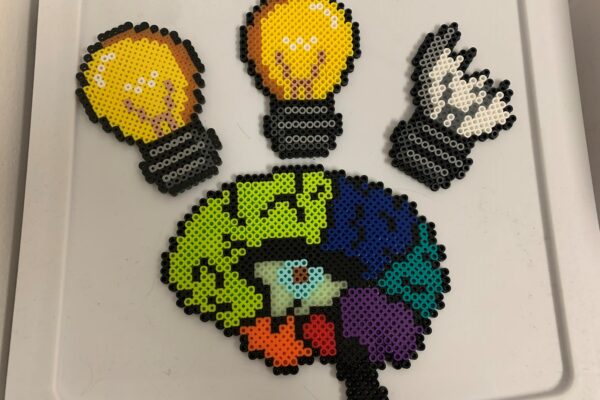
Jared Schoening- Traumatic Brain Injuries, Symbolized

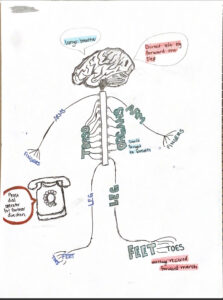 I decided to create a drawing, likening the CNS and PNS to an old school telephone operating system. I used the spinal cord as the switchboard of the telephone system. The operator is the brain. Then there are wires, like telephone lines down the street, that are the PNS. They take the message that the CNS specifically meant for the toes down to the toes. Or the message that was meant for the arms, to the arms.
I decided to create a drawing, likening the CNS and PNS to an old school telephone operating system. I used the spinal cord as the switchboard of the telephone system. The operator is the brain. Then there are wires, like telephone lines down the street, that are the PNS. They take the message that the CNS specifically meant for the toes down to the toes. Or the message that was meant for the arms, to the arms.
I made my STEAM project about osteoporosis because I enjoyed learning about the disease. The woman in the beginning is drinking milk, but she hasn’t been having enough calcium as seen by the Ca++ tanks on the second page. This causes the osteoclasts to break down more bone than they’re supposed to. This leads the personified osteoblast at the end of the comic to be surprised that they’ll be unable to keep up with the osteoclasts’ activity.

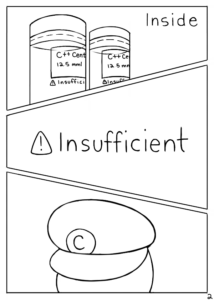


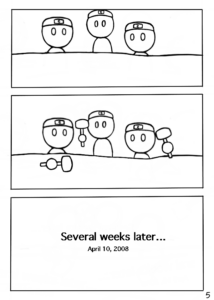
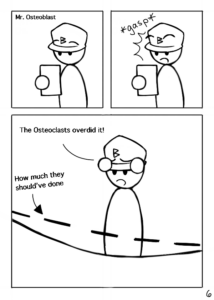
This is a spine representing scolioses. You might notice the very large curve that will cause a lot of pain and the body to feel unbalanced. Everything is labeled and each section of the spine is color-coded. The smaller picture to the right is an X-ray of a severe scolioses case.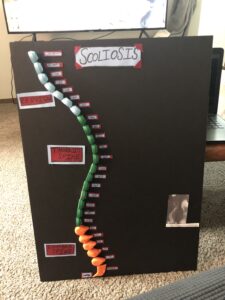
There are 6 main senses, each with a variety of sub-modalities that get filtered by your thalamus. If your thalamus is not working properly you will get sensory overload as it allows too much sensors into your cortex. This is commonly found in people with ADHD, Autism, people with brain trauma and more.


The eye is a fascinating organ of the body that holds all the little components and connections that allow one to carry out one of their most important senses; sight. So how can the stimulus of the process of vision—visible light– also be something that can kill the receptors that allow for it. To understand how light can kill photoreceptors, one must first understand how light initiates the process of phototransduction, what photoreceptors do, and what they are.
The process of phototransduction occurs when light—or a photon—is converted into an electrical signal in the retina. This electrical signal will be sent to the brain to be formed into the images we see every day. In a more detailed description, phototransduction has four main steps; the receptor protein (rhodopsin) is activated, the activated rhodopsin stimulates the G-protein transduction (GTP) which is then turned into guanosine diphosphate (GDP). Next, the transducin activates phosphodiesterase (PDE), which works to convert cGMP to GMP—these are the secondary messengers. Due to the cGMP quantity decreasing, the transduction channels close. This in turn decreases the sodium (Na+) current completing the process of phototransduction.
The photoreceptor cells found in the retina are called rods and cones. There are approximately one hundred and twenty million rod cells, and six million cone cells in the human retina. Rods are cylindrical in shape. They are extremely sensitive to low-intensity light making them perfect for whatever amount of night vision we have. Rods also allow us to perceive the size, shape, and brightness of images we take in. Cones on the other hand, work best in brighter lights and are responsible for our ability to see in color, as well as allow us to identify fine detail.
I am sure we all have the shared childhood experience of staring directly into the sun as our parents yelled warnings of going completely blind and burning our retinas right off. Was there any validity to their warnings? The truth is, they were absolutely right—maybe not entirely accurate about the “burning retinas”— but a continuous light stimulating the process of transduction can indeed cause rod apoptosis (rod cell death). However, one does not require such a strong stimulant as sunlight; even a more moderate illumination given enough time can lead to rod apoptosis. If transduction is a natural process, then why can it kill photoreceptors? It is speculated that the continuous activation of visual transduction can lead the calcium (Ca2+) concentration that helps to keep one’s eye healthy to lower and keep doing so.
One of the most amazing things about the human body is that it has the ability to make small adaptions to solve problems. In this particular case, rods have evolved so that there are protective measures in place to keep the calcium from going too low. These measures are; the ability to modify channels and the transport of ions. Another adaption that occurred to deal with prolonged light exposure is the migration of transduction proteins to a different part of the cell than its previous location. The section of the cell that holds the pigment rhodopsin can be shortened as well as re-elongated to help with prolonged transduction activation.
All in all, it would take a lot for one’s rods and cones to be killed by light. However, it can happen—so let us heed our parents’ warnings and avoid spend hours staring at the fireball in the sky.
2 Comments
I decided to do my project on osteoporosis because it was very interesting to me, and a few of my family members have osteoporosis so I wanted to learn a little more about it. My drawing shows what happens inside of a healthy bone, and what happens inside of a bone with osteoporosis.
One CommentMy STEAM project is about the five major classes of Antibodies or immunoglobulins called IgM, IgA, IgD, IgG, and IgE. Though they are found throughout the body’s secretions they produced by effector B cells and are secreted by Plasma cells. Though some Antibodies vary in size and structure they each have the minimum characteristics of antibody monomers (four protein chains bound by disulfide chains), the lightest of which forms the antigen binding site. The heavy monomers (high molecular weight) contain variable and constant regions, the constant region means that the amino acids are the same throughout the classes of Antibodies, the variable region is unique for every Antibody. Antigens bind at the ends of each Antibody structure at the variable regions where it forms a y-shape. The other end of the Antibody binds to B-cells, phagocytes, mast cells, or simply float free in the plasma depending on which Antibody it is.I couldn’t figure out how to post multiple pictures so please go to the link to view the paintings. –Antibodies in Waterco
One Comment